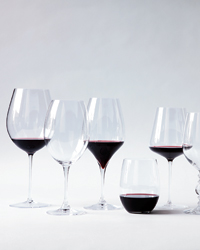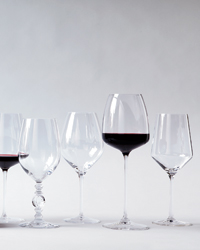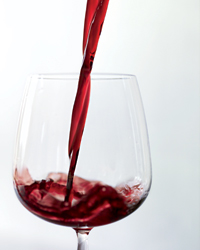Cabernet Sauvignon has an image problem. It’s one of the most popular and widely grown wine grapes in the world, but lately, when I mention it to friends who are sommeliers, they look at me askance, as though I’d said something like, “Well, I don’t know—the Taliban doesn’t seem all that bad to me.”
This reaction is particularly true when it comes to New World Cabernet, which is to say anything from Australia, South America or the United States, especially Napa Valley, which seems to be the wellspring of Cabernets-that-sommeliers-don’t-like. The sins that New World Cabernet has committed are, apparently, these: It is too big, too ripe, too intense in flavor, too tannic, too fruity, too oaky, too high in alcohol and too expensive. It is the ruin of an exquisite wine-and-food-pairing experience. Evidently, what we all should be drinking, if we had the sense God gave an ant, is something streamlined and zippy, with bright acidity. Which translates as, “If it isn’t Burgundy, the heck with it.”
This attitude bugs me for a lot of reasons.
First, it’s reductive. “Big” doesn’t automatically mean “unbalanced.” Sure, some warm-climate Cabernets are thudding monsters, but some light, cool-climate reds (like bad Burgundy) can be searingly acidic. The key is balance.
Second, sometimes big red wines—massive, in-your-face, superrich red wines—are a pleasure. They aren’t subtle, but the opening of Beethoven’s Fifth Symphony isn’t particularly subtle, either. Nor is a bacon double cheeseburger. But on the days when I want a bacon double cheeseburger, I really want one. Preferably accompanied by a big Cabernet. While listening to Beethoven’s Fifth. Loud.
Third, it’s poppycock to say that big red wines don’t go with food. They go perfectly well with food: big food. Braised short ribs, pork belly, venison stew, no problem. Dover sole, maybe rethink. You wouldn’t make a linebacker ride a pony, would you?
Finally, it has become cool to dislike ripe New World wines. You lose your edgy-wine-dude bona fides the moment you mention that you actually enjoyed a glass of Caymus Cabernet. In fact, it’s very easy to create a hipster wine lexicon of the cool and uncool: fruit, uncool; acidity, cool; new oak, uncool; clay amphorae, cool; enology degree from UC Davis, uncool; apprenticeship with technology-rejecting European winemaker, cool; and so on. If cool is your objective, you are all set. But you are also, unfortunately, stiflingly pretentious.
Of course, there are some sommeliers and wine directors out there who will proclaim their love for a big, bold, emphatic Cabernet Sauvignon. Seth Liebman, formerly the wine director at Michael’s in Manhattan and now a consultant to a number of different restaurants, says, “My experience is that most people outside of our little microcosm of the wine world, the real people of this world, really enjoy drinking California Cabernets. But a lot of sommeliers write off those wines as big American fruit, big American wine. And instead, they’ll have nine wines from the Jura region of France on their list. Come on—one isn’t enough? It’s like you’re running a theater, and the public wants to see Pirates of the Caribbean, and you say you’re only going to show Eisenstein movies.”
It should also be stated that, just as big doesn’t equal bad, it doesn’t necessarily equal good, either. Not long ago, I had a relatively acclaimed bottle of Napa Valley Zinfandel with a friend and fellow wine writer. Now, this wine was bad, truly bad, and we hated it in proportion to its badness, which is to say a lot. But it wasn’t bad because it was big; it was bad because it was unbalanced—way too much fruit, zero acidity, tons of oak. It was also proof that making a big wine that is balanced, and that has nuance and complexity as well as sheer oomph—whether it’s Cabernet or Zinfandel or any other variety—isn’t an easy thing, even for a top winemaker. (The fellow who made this wine has received boatloads of recognition, and justifiably, but even Roger Federer blows it occasionally.)
Anyway: I admit to being an intensity junkie. The sight of a giant steak thrills me; so does driving really fast. Loud music, whether Beethoven or Iggy Pop, makes me happy. I even like bungee-jumping, though why exactly I enjoy falling 150 feet face-first toward a river is probably a question for a good shrink. The point, though, is that I don’t need any of those things every single day. Without access to them once in a while, I’m quite sure the slow, steady drip of time would eventually drive me mad with boredom, but once in a while is sufficient. It does the trick. And that’s true for a lot of people. And maybe that’s why we like Cabernet—big, luscious, volume-turned-up-to-11 Cabernet. It may be hard to pair with some foods, but it sure goes great with life. Which is why, the next time I go skydiving blindfolded over Machu Picchu, I’m definitely taking a bottle or two with me.
The amount of layered flavor that winemaker Juan Muñoz Oca packs into this $15 bottle is astounding.
This tobacco-inflected, smoky Chilean Cabernet, with its give-me-a-big-steak tannins, proves that intensity doesn’t have to be solely about fruit.
The talents of winemaker Paul Hobbs meet ripe Argentinean grapes in a juicy, black-cherry-scented red.
A balancing act of chewy black fruit, grippy tannins and mocha-vanilla oak.
The warmth of Australia’s Barossa Valley provides the plush depth; good winemaking keeps the flavors focused.
The rocky slopes of Pritchard Hill give this Napa Cab fierce, muscular intensity.
Napa cult-Cab style at a non-cult price, with voluminous, soft tannins, waves of silky black plum and blackberry fruit.
A profound Cabernet from Spain’s Penedès region, Mas La Plana’s violet-spice scent and vivid fruit are bolstered by a formidable structure.
Many believe a larger glass shows off a big Cabernet’s aroma best. Yet the designs below—large and small—all passed the F&W sniff test.

From left to right:
Movia Bordeaux glass (4.5"). $99 a pair; italianwinemerchants.com.
Robert Mondavi Bordeaux glass by Waterford. $50 a pair; bloomingdales.com.
Riedel Vitis Cabernet glass. $85 a pair; riedel.com.
Riedel O Bordeaux wine tumbler. $25 a pair; williams-sonoma.com.
Zalto Denk’Art Bordeaux glass by Aldo Sohm. $61 each; winemonger.com.

Baccarat Woods of Euphoria Bordeaux glass. $295 each; baccarat.neimanmarcus.com.
Holmegaard Cabernet glass. $40 each; fitzsu.com.
Rosenthal TAC 02 Bordeaux glass. $50 a pair; tableartonline.com.
Schott Zwiesel Pure Cabernet glass (3.6"). $13 each; crystalclassics.com.

Cabernet Sauvignon is known for its deep color, rich tannins and remarkable intensity of flavor—and there are over 600,000 acres of it planted worldwide. Photo © Seth Smoot.
No comments:
Post a Comment